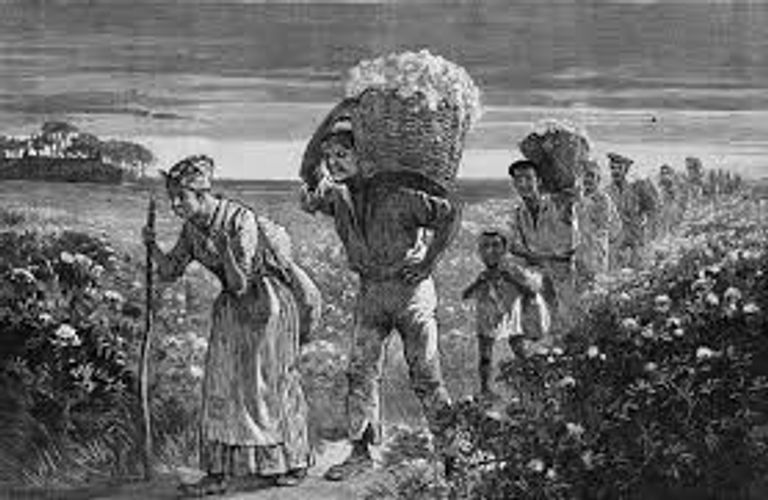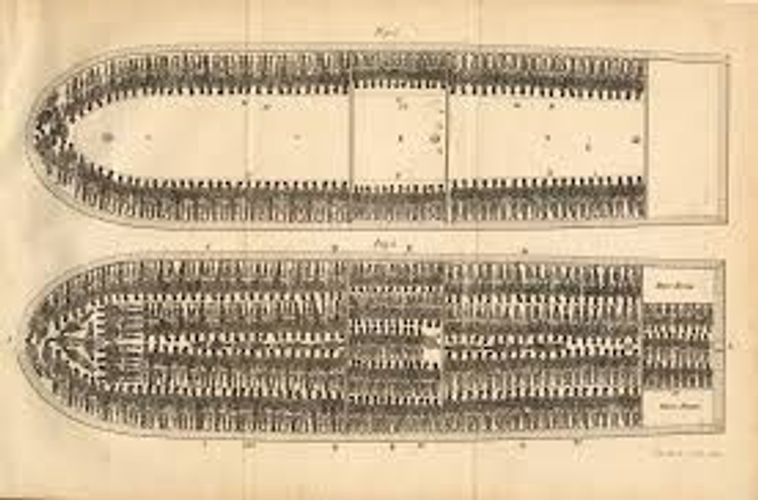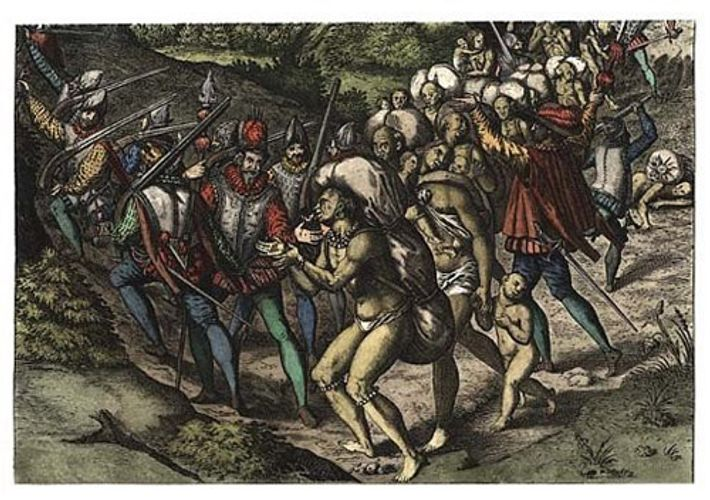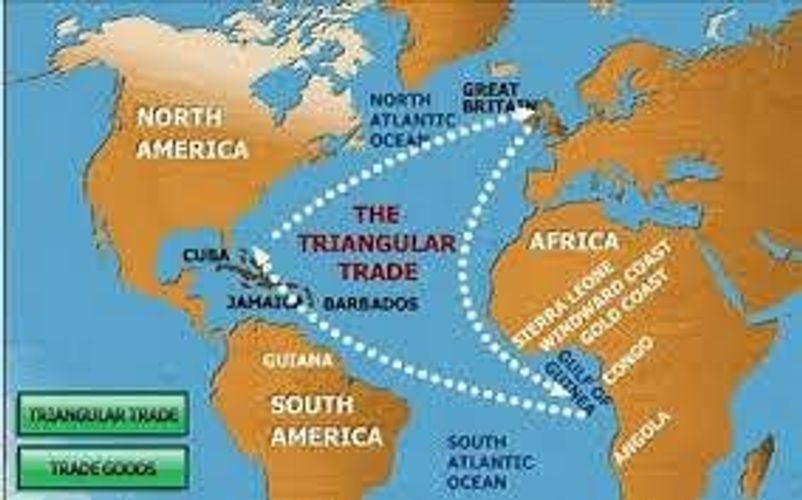Enslavement and the African Trade Free

Enslavement and the African Trade
The trade of enslaved humans is generally considered to have begun with the arrival of 225 Africans to a port in what European city?
Lagos

Lagos, Portugal was the port where in 1443, 225 Africans were brought into Portugal to relieve the handicap of agricultural labor. In 1444 Lagos, Portugal became the site of the first official European slave market (Mercado de Escravos).
What is NOT a name used to describe the history and experiences of African during the Trans Atlantic slave trade?
Ujasiri

Ujasiri is the Swahili word for “courage” and is not a name used to describe the Trans Atlantic slave trade. Maafa is a Swahili term meaning “great disaster or tragedy” and was popularized in the 1990s as was African Holocaust and Holocaust of Enslavement.
Which period served as the most intensive years of the African slavery era?
1700-1850

The period between 1700-1850 was the most intensive years of the African slave trade. The majority of enslaved Africans were brought to British North America between 1700 and 1780 and over a million more by 1850.
Which of the following was the name of the first ship to leave Britain for Africa for the sole purpose of capturing Africans for enslavement?
The Jesus

The good ship Jesus was the first ship in 1562, captained by Sir John Hawkins, to leave Britain and engage in the slave trade. They captured 300 Africans.
What was the number of enslaved people that the majority of owners had on their land?
15 or fewer

Typical images of southern plantations are thought of as having hundreds of enslaved people. But this is myth; while many southern farmers certainly enslaved people prior to emancipation, the majority of plantations had 15 or fewer enslaved people.
The transport of enslaved Africans across the Atlantic was called what?
The Middle Passage

The Middle Passage was the term popularly used for the part of the voyage slave ships used crossing the Atlantic Ocean from Africa to the Americas. It was called this because it was the middle section of the trade route taken by slave ships.
The largest company trading in African humans was owned by what country?
Holland

On June 3, 1621, the Dutch West Indies Company was granted a charter for a trade monopoly in the West Indies by the Republic of the Seven United Netherlands and given jurisdiction over the Atlantic slave trade in Brazil, the Caribbean and North America; thus Holland became home of the largest company trading in Africans.
The first European fort to be built in Africa was built by whom?
The Portuguese

Built in 1482 in what is now Ghana, by Portuguese traders, El Mina Castle was the first European slave-trading fort to be built in Africa.
What was the name for the place where brutal methods of physical and psychological conditioning of enslaved Africans occurred?
Seasoning Camps

Seasoning was a system of torture inflicted on captured Africans for the purpose of “breaking” them in (i.e. breaking the will of free Africans) and conditioning them for their new lives as enslaved people. Seasoning camps were where this abusive conditioning occurred. Many of these were held in the Caribbean, Jamaica, in particular.
Approximately how many revolts or insurrections occurred during the period of enslavements?
200-300

Using historian Herbert Aptheker’s definition of a slave revolt as an action involving 10 or more enslaved people with “freedom as the apparent aim and contemporary references labeling the event as an uprising, plot, insurrection or the equivalent of these”, the number of revolts in the US during the period exceeded 200, some say even as many as 300+.
Which religious hymn was written by a slave ship captain turned minister?
Amazing Grace

Amazing Grace was written by a former slave trader and sea captain, John Newton, several decades after he left slave trading and became a Christian minister. Contrary to popular belief, he did not write the song and free all his slaves immediately after surviving a disastrous storm at sea.
One of the most famous slave mutinies was led by Joseph Cinque on what ship?
The Amistad

Joseph Cinque was a West African who led a slave mutiny on the Cuban ship, Amistad, in 1839; he was captured and imprisoned. His case made it all the way to the Supreme Court of the U.S. where he won his case and was returned to his home country, Sierra Leone. In 1997, Stephen Spielberg produced the movie, The Amistad, depicting Cinque’s experience.
Approximately how many Africans were transported during the Atlantic Slave Trade?
10-15 million

According to the Trans-Atlantic Slave Trade Database, about 12.5 million Africans were shipped to the New World. About 10.7 million are said to have survived the voyage which means that close to 2 million Africans died at sea.
Which Caribbean country served as the “point of exchange and distribution” of enslaved people in the West Indies?
Cuba

During the 1600's Cuba became the point of exchange and distribution for captured Africans being sent to other West Indian colonies for enslavement.
The first 20 Africans were brought as indentured servants to settlers of what colony?
Virginia

August of 1619, 20 Africans on board a Dutch vessel were taken into port at the English colony of Jamestown, Virginia. These Africans were subsequently made indentured servants aside many European indentured servants. With no slave laws in place at the time, these Africans were given the same opportunities for freedom as were the white indentured servants.
During the height of slave trafficking in the 19th century, how long was the average slave voyage?
5-12 weeks

During the earliest years of trafficking (1500s), the voyage from Africa to the New World took several months, but by the 1800s, this voyage was reduced to six to eight weeks; however, bad weather could increase this to 12 weeks.
In 1571 France made a royal declaration that stated which of the following?
“France, mother of liberty, permits no slaves.”

The government of France refused to tolerate slavery in its country and when a slave trader brought a ship load of enslaved people to the country in 1571 and attempted to sell them, the government intervened with the royal declaration “France, mother of liberty, permits no slaves.”. However, the country was not against slavery, just against slavery in its country as France tolerated the enslavement of more Africans in the West Indies than any other country.
In what year was the first cargo of African enslaved humans shipped directly from Africa to the West Indies?
1518

While Spanish colonists imported a cargo of enslaved Africans from Spain to Hispaniola 1501, the first captured Africans sent directly from Africa to the Spanish plantations and mines in the West Indies arrived in 1518.
Who was the first enslaved group of people in the Americas?
Indians

Before the importation and enslavement of Africans, European nations used Indians as slaves in North America, the Caribbean and in Europe.
Which was the largest “slave rebellion” in the U.S.?
Louisiana German Coast Rebellion (1811)

The little-known Louisiana German Coast Rebellion of 1811, started by Charles Deslondes on a plantation outside New Orleans, began with about 25 freedom fighters, but the numbers swelled to 125 by some counts and 300 by others. It became the largest rebellion of enslaved people in U.S. history. Prior to 1811, the Stono Rebellion had been the largest. Waged in 1739, it occurred in the colony of South Carolina, before the U.S. gained its independence.
The first Portuguese fort in Africa was on the Gold Coast and called what?
El Mina

Built in 1482 in what is now Ghana, by Portuguese traders, El Mina Castle was the first European slave-trading fort to be built in Africa.
In the triangular trade system, which area was NOT involved?
Asia

The triangular slave trade included ships sailing from Europe with European-made products like rum, copper, clothes, guns, ammunition, etc. to the African coast to trade for captured African human beings. The ships then crossed the Atlantic packed with human cargo sailing for The Americas, especially the West Indies, where Africans were sold to plantations. The profits ship captains earned from the sale of these Africans was then used to purchase raw products like tobacco, sugar, and molasses after which these raw products were shipped to Europe. These raw products were turned into European-made products and the triangle began again. Asia was not a part of the slave trade.
What was the Spanish royal permit called that provided the rights to merchants and mariners from other countries to purchase enslaved people in Africa and sell them in Spanish colonies in the Americas?
The assiento

“The assiento” was a slave trade treaty between the king of Spain and other countries which allowed merchants from these other countries to supply enslaved Africans to Spanish dependencies or colonies.
Which of the following partnerships first controlled the slave trade?
Spanish and Portuguese

In the early 17th century, Portugal, which was supplying its own supply of enslaved Africans, entered into a contract with Spain to supply bondsmen for the Spanish colonies in the New World.
What was the length of the average work day of enslaved Blacks?
10-12 hours

Enslaved Africans worked "from day clean to first dark", six days a week, with Sundays off. The average work day generally amounted to 10-12 hours, except during planting and harvest seasons when the work period went as high as 16 hours a day or more.
Slavery remains the open wound of America; this quiz will teach you the roles people of African descent played as this horrid institution was developed in this country.
Related Posts
Login
Upgrade your Membership
This Quizz Only For Paid Members
Upgrade Your Account First




